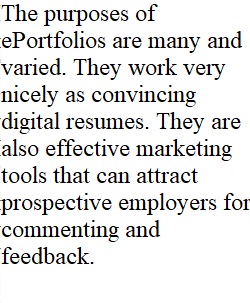


Q In this discussion you’ll have a chance to evaluate the pros and cons of the different tools for creating ePortfolios. Directions If you are new to ePortfolios: 1. Determine if you would like your ePortfolio to be public or private and explain why. 2. Choose two or more of the following ePortfolios to look at: CANVAS examples: Physical Geography Cultural Geography WIX examples: College 1 (Links to an external site.) Oceanography (Links to an external site.) Weebly examples: College 1 (Links to an external site.) Oceanography (Links to an external site.) 3. Compare your two choices for the following: Do you like the final products/examples? If yes, what do you like about them? If no, what are you looking for in a web design site? 4. Based on your assessment, describe what tool you are most interested in for building your ePortfolio and why. If you want to go directly to a tool website to check out how to use the tool: • CANVAS ePortfolio (Links to an external site.) (you can check this tool out here within CANVAS, this link will take you to the information page about CANVAS); • WiX (Links to an external site.) • Weebly (Links to an external site.) If you have completed an ePortfolio in a previous class at PCC: 1. Explain why you chose the tool you used. 2. Describe your experience with the tool (ease of use, tutorials used, how long it took to build your pages, etc.). 3. Pass along any advice/suggestions you have for using the tool. 4. If you have a public ePortfolio, share your URL.
View Related Questions